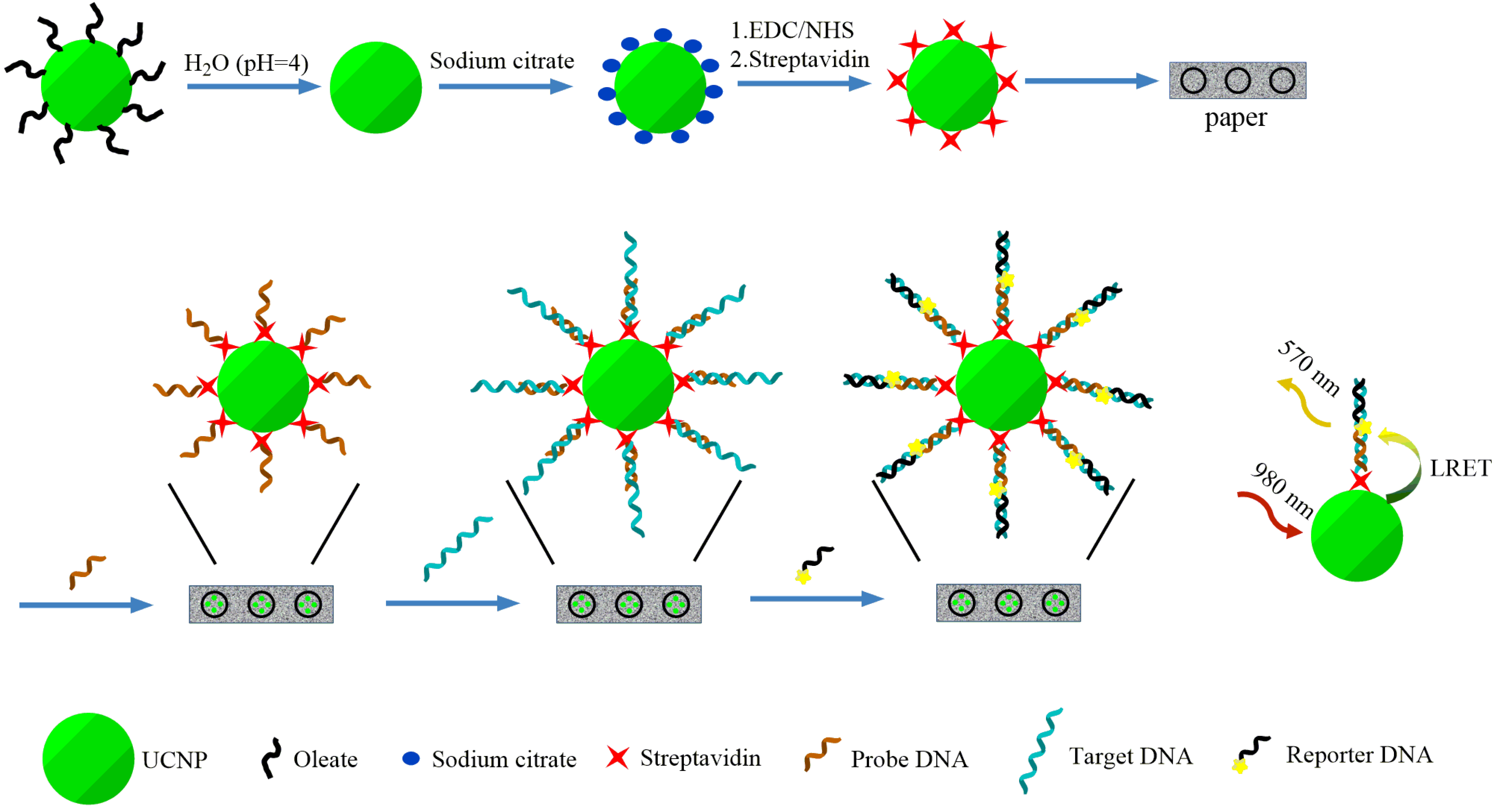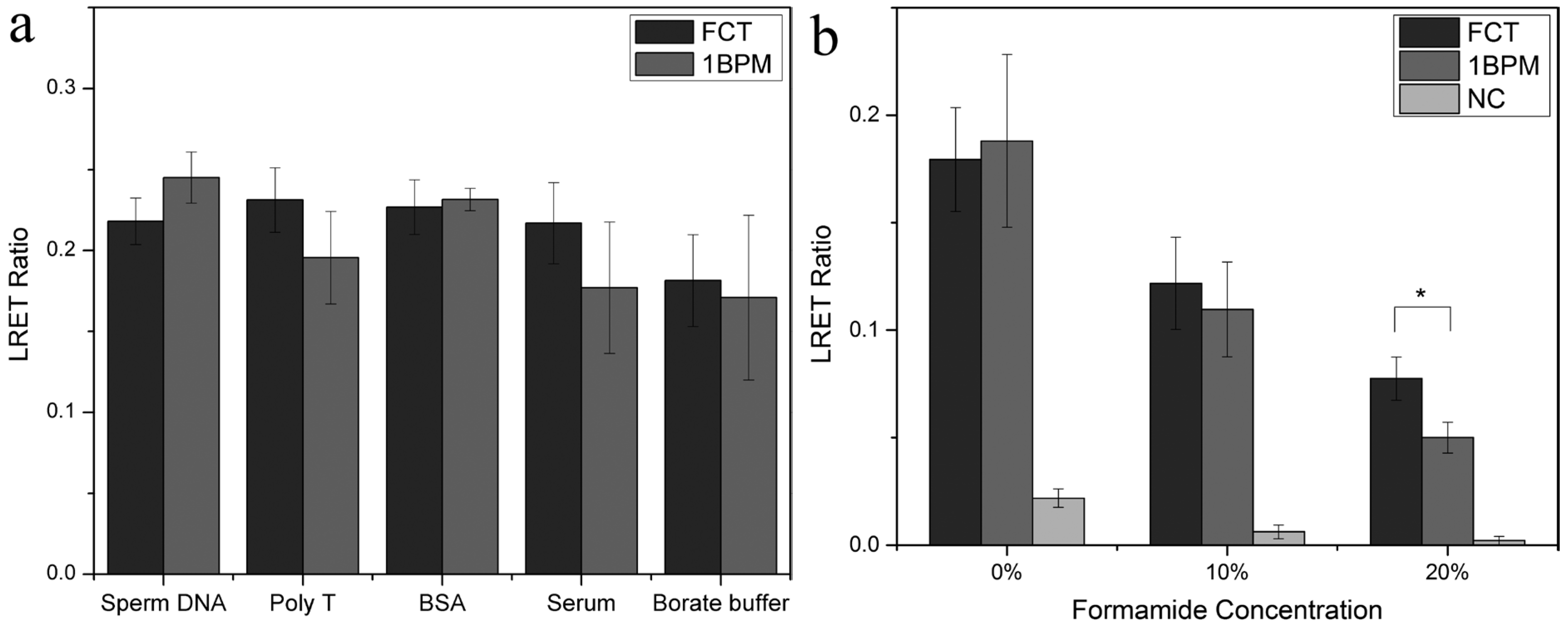A Paper-Based Sandwich Format Hybridization Assay for Unlabeled Nucleic Acid Detection Using Upconversion Nanoparticles as Energy Donors in Luminescence Resonance Energy Transfer
Abstract
:1. Introduction
2. Results and Discussion

2.1. Synthesis and Functionalization of Core/Shell UCNPs


2.2. Performance of the Hybridization Assay

2.3. 1BPM Discrimination Assay

2.4. Hybridization Assay for Samples with a Complex Matrix Composition

3. Experimental Section
3.1. Reagents
| E. coli hlyA probe | biotin-5′-TTC AGT TAA TCC TAC AAC-3′ |
| E. coli hylA FCT | 5′-GGT GCA GCA GAA AAA GTT GTA GGA TTA ACT GAA-3′ |
| E. coli hylA 1BPM | 5′-GGT GCA GCA GAA AAA GTT GTA GAA TTA ACT GAA-3′ |
| E. coli hylA NC | 5′-ATT TTG TCT GAA ACC CTG TAA GGA AAA TAA AGG-3′ |
| E. coli hylA reporter | Cy3-5′-TTT TTC TGC TGC ACC-3′ |
| Poly T (T30) | 3′-TTTTTTTTTTTTTTTTTTTTTTTTTTTTTT-5′ |
3.2. Instrumentation and Characterization
3.3. Procedures
3.4. Synthesis of Ligand-Free Water Soluble UCNP
3.5. Coating the Ligand-Free UCNP with Sodium Citrate
3.6. Conjugation of Avidin onto SC-UCNP
3.7. Immobilization of Avidin-UCNPs on Paper Substrates and Bioconjugation of Oligonucleotide Probe
3.8. DNA Hybridization Assay
3.9. Selectivity Experiments
3.10. Data Analysis
4. Conclusions
Acknowledgments
Author Contributions
Conflicts of Interest
References
- Wang, F.; Liu, X.G. Upconversion multicolor fine-tuning: Visible to near-infrared emission from lanthanide-doped NaYF4 nanoparticles. J. Am. Chem. Soc. 2008, 130, 5642–5643. [Google Scholar] [CrossRef] [PubMed]
- Chatteriee, D.K.; Rufalhah, A.J.; Zhang, Y. Upconversion fluorescence imaging of cells and small animals using lanthanide doped nanocrystals. Biomaterials 2008, 29, 937–943. [Google Scholar] [CrossRef] [PubMed]
- Li, H.; Wang, L.Y. NaYF4:Yb3+/Er3+ nanoparticle-based upconversion luminescence resonance energy transfer sensor for mercury(II) quantification. Analyst 2013, 138, 1589–1595. [Google Scholar] [CrossRef] [PubMed]
- Yao, L.M.; Zhou, J.; Liu, J.L.; Feng, W.; Li, F.Y. Iridium-complex-modified upconversion nanophosphors for effective LRET detection of cyanide anions in pure water. Adv. Funct. Mater. 2012, 22, 2667–2672. [Google Scholar] [CrossRef]
- Ye, W.W.; Tsang, M.K.; Liu, X.; Yang, M.; Hao, J. Upconversion luminescence resonance energy transfer (LRET)-based biosensor for rapid and ultrasensitive detection of avian influenza virus H7 subtype. Small 2014, 10, 2390–2397. [Google Scholar] [CrossRef] [PubMed]
- Noor, M.O.; Tavares, A.J.; Krull, U.J. On-chip multiplexed solid-phase nucleic acid hybridization assay using spatial profiles of immobilized quantum dots and fluorescence resonance energy transfer. Anal. Chim. Acta 2013, 788, 148–157. [Google Scholar] [CrossRef] [PubMed]
- Noor, M.O.; Krull, U.J. Camera-based ratiometric fluorescence transduction of nucleic acid hybridization with reagentless signal amplification on a paper-based platform using immobilized quantum dots as donors. Anal. Chem. 2014, 86, 10331–10339. [Google Scholar] [CrossRef] [PubMed]
- Wang, L.; Yan, R.; Huo, Z.; Wang, L.; Zeng, J.; Bao, J.; Wang, X.; Peng, Q.; Li, Y. Fluorescence resonant energy transfer biosensor based on upconversion-luminescent nanoparticles. Angew. Chem. Int. Ed. Engl. 2005, 44, 6054–6057. [Google Scholar] [CrossRef] [PubMed]
- Hu, X.; Wei, T.; Wang, J.; Liu, Z.E.; Li, X.; Zhang, B.; Li, Z.; Li, L.; Yuan, Q. Near-infrared-light mediated ratiometric luminescent sensor for multimode visualized assays of explosives. Anal. Chem. 2014, 86, 10484–10491. [Google Scholar] [CrossRef] [PubMed]
- Alonso-Cristobal, P.; Vilela, P.; El-Sagheer, A.; Lopez-Cabarcos, E.; Brown, T.; Muskens, O.L.; Rubio-Retama, J.; Kanaras, A.G. Highly sensitive DNA sensor based on upconversion nanoparticles and graphene oxide. ACS Appl. Mater. Interface 2015, 7, 12422–12429. [Google Scholar] [CrossRef] [PubMed]
- Ding, Y.; Zhu, H.; Zhang, X.; Zhu, J.J.; Burda, C. Rhodamine B derivative-functionalized upconversion nanoparticles for FRET-based Fe3+-sensing. Chem. Commun. 2013, 49, 7797–7799. [Google Scholar] [CrossRef] [PubMed]
- Doughan, S.; Uddayasankar, U.; Krull, U.J. A paper-based resonance energy transfer nucleic acid hybridization assay using upconversion nanoparticles as donors and quantum dots as acceptors. Anal. Chim. Acta 2015, 878, 1–8. [Google Scholar] [CrossRef] [PubMed]
- Liu, J.; Cheng, J.; Zhang, Y. Upconversion nanoparticle based LRET system for sensitive detection of MRSA DNA sequence. Biosens. Bioelectron. 2013, 43, 252–256. [Google Scholar] [CrossRef] [PubMed]
- Martinez, A.W.; Phillips, S.T.; Carrilho, E.; Thomas, S.W.; Sindi, H.; Whitesides, G.M. Simple telemedicine for developing regions: Camera phones and paper-based microfluidic devices for real-time, off-site diagnosis. Anal. Chem. 2008, 80, 3699–3707. [Google Scholar] [CrossRef] [PubMed]
- Martinez, A.W.; Phillips, S.T.; Whitesides, G.M. Three-dimensional microfluidic devices fabricated in layered paper and tape. Proc. Natl. Acad. Sci. USA 2008, 105, 19606–19611. [Google Scholar] [CrossRef] [PubMed]
- Zhou, F.; Krull, U.J. Spectrally matched duplexed nucleic acid bioassay using two-colors from a single form of upconversion nanoparticle. Anal. Chem. 2014, 86, 10932–10939. [Google Scholar] [CrossRef] [PubMed]
- Zhou, F.; Noor, M.O.; Krull, U.J. Luminescence resonance energy transfer-based nucleic acid hybridization assay on cellulose paper with upconverting phosphor as donors. Anal. Chem. 2014, 86, 2719–2726. [Google Scholar] [CrossRef] [PubMed]
- Noor, M.O.; Hrovat, D.; Moazami-Goudarzi, M.; Espie, G.S.; Krull, U.J. Ratiometric fluorescence transduction by hybridization after isothermal amplification for determination of zeptomole quantities of oligonucleotide biomarkers with a paper-based platform and camera-based detection. Anal. Chim. Acta 2015, 885, 156–165. [Google Scholar] [CrossRef] [PubMed]
- Connelly, J.T.; Rolland, J.P.; Whitesides, G.M. “Paper machine” for molecular diagnostics. Anal. Chem. 2015, 87, 7595–7601. [Google Scholar] [CrossRef] [PubMed]
- Zuo, X.L.; Xiao, Y.; Plaxco, K.W. High specificity, electrochemical sandwich assays based on single aptamer sequences and suitable for the direct detection of small-molecule targets in blood and other complex matrices. J. Am. Chem. Soc. 2009, 131, 6944–6945. [Google Scholar] [CrossRef] [PubMed]
- Derfus, A.M.; Chan, W.C.W.; Bhatia, S.N. Probing the cytotoxicity of semiconductor quantum dots. Nano Lett. 2004, 4, 11–18. [Google Scholar] [CrossRef]
- Oberdorster, G.; Oberdorster, E.; Oberdorster, J. Nanotoxicology: An emerging discipline evolving from studies of ultrafine particles. Environ. Health Perspect. 2005, 113, 823–839. [Google Scholar] [CrossRef] [PubMed]
- Carling, C.J.; Nourmohammadian, F.; Boyer, J.C.; Branda, N.R. Remote-control photorelease of caged compounds using near-infrared light and upconverting nanoparticles. Angew. Chem. Int. Ed. Engl. 2010, 49, 3782–3785. [Google Scholar] [CrossRef] [PubMed]
- Noor, M.O.; Krull, U.J. Paper-based solid-phase multiplexed nucleic acid hybridization assay with tunable dynamic range using immobilized quantum dots as donors in fluorescence resonance energy transfer. Anal. Chem. 2013, 85, 7502–7511. [Google Scholar] [CrossRef] [PubMed]
- Noor, M.O.; Krull, U.J. Microfluidics for the deposition of density gradients of immobilized oligonucleotide probes; developing surfaces that offer spatial control of the stringency of DNA hybridization. Anal. Chim. Acta 2011, 708, 1–10. [Google Scholar] [CrossRef] [PubMed]
- Corstjens, P.L.A.M.; Zuiderwijk, M.; Nilsson, M.; Feindt, H.; Sam Niedbala, R.; Tanke, H.J. Lateral-flow and up-converting phosphor reporters to detect single-stranded nucleic acids in a sandwich-hybridization assay. Anal. Biochem. 2003, 312, 191–200. [Google Scholar] [CrossRef]
- Jayakumar, M.K.G.; Idris, N.M.; Zhang, Y. Remote activation of biomolecules in deep tissues using near-infrared-to-UV upconversion nanotransducers. Proc. Natl. Acad. Sci. USA 2012, 109, 8483–8488. [Google Scholar] [CrossRef] [PubMed]
- Bogdan, N.; Vetrone, F.; Ozin, G.A.; Capobianco, J.A. Synthesis of ligand-free colloidally stable water dispersible brightly luminescent lanthanide-doped upconverting nanoparticles. Nano Lett. 2011, 11, 835–840. [Google Scholar] [CrossRef] [PubMed]
- Bogdan, N.; Rodriguez, E.M.; Sanz-Rodriguez, F.; de la Cruz, M.C.; Juarranz, A.; Jaque, D.; Sole, J.G.; Capobianco, J.A. Bio-functionalization of ligand-free upconverting lanthanide doped nanoparticles for bio-imaging and cell targeting. Nanoscale 2012, 4, 3647–3650. [Google Scholar] [CrossRef] [PubMed]
- Peng, J.J.; Sun, Y.; Zhao, L.Z.; Wu, Y.Q.; Feng, W.; Gao, Y.H.; Li, F.Y. Polyphosphoric acid capping radioactive/upconverting NaLuF4:Yb,Tm,153Sm nanoparticles for blood pool imaging in vivo. Biomaterials 2013, 34, 9535–9544. [Google Scholar] [CrossRef] [PubMed]
© 2015 by the authors; licensee MDPI, Basel, Switzerland. This article is an open access article distributed under the terms and conditions of the Creative Commons Attribution license (http://creativecommons.org/licenses/by/4.0/).
Share and Cite
Zhou, F.; Noor, M.O.; Krull, U.J. A Paper-Based Sandwich Format Hybridization Assay for Unlabeled Nucleic Acid Detection Using Upconversion Nanoparticles as Energy Donors in Luminescence Resonance Energy Transfer. Nanomaterials 2015, 5, 1556-1570. https://doi.org/10.3390/nano5041556
Zhou F, Noor MO, Krull UJ. A Paper-Based Sandwich Format Hybridization Assay for Unlabeled Nucleic Acid Detection Using Upconversion Nanoparticles as Energy Donors in Luminescence Resonance Energy Transfer. Nanomaterials. 2015; 5(4):1556-1570. https://doi.org/10.3390/nano5041556
Chicago/Turabian StyleZhou, Feng, M. Omair Noor, and Ulrich J. Krull. 2015. "A Paper-Based Sandwich Format Hybridization Assay for Unlabeled Nucleic Acid Detection Using Upconversion Nanoparticles as Energy Donors in Luminescence Resonance Energy Transfer" Nanomaterials 5, no. 4: 1556-1570. https://doi.org/10.3390/nano5041556






